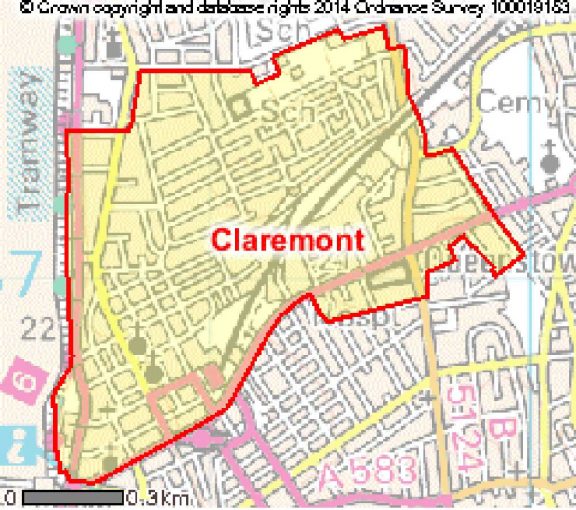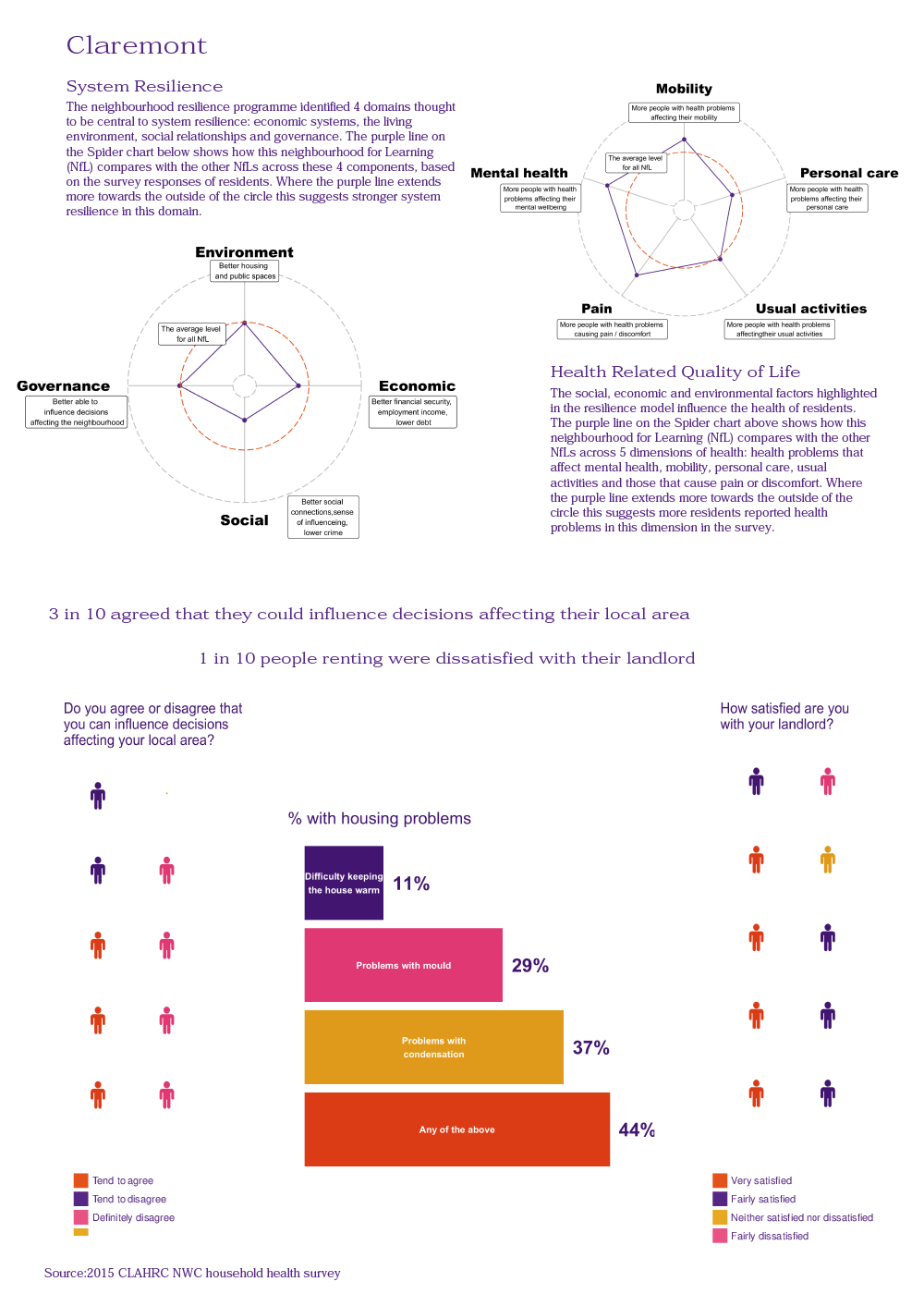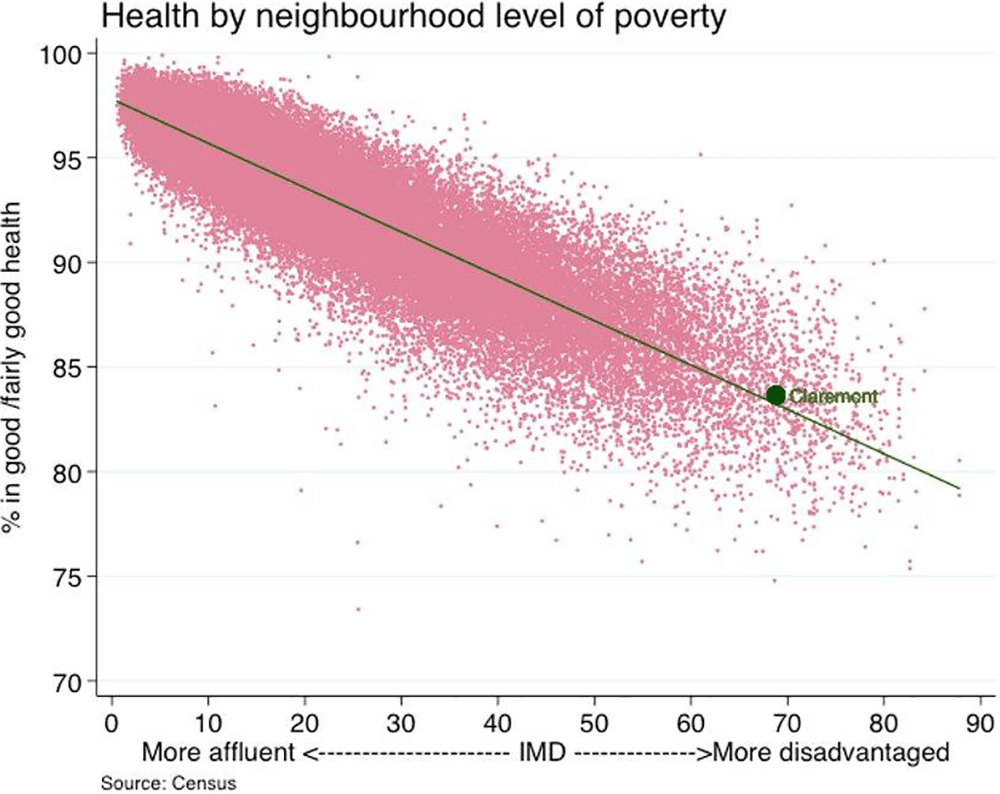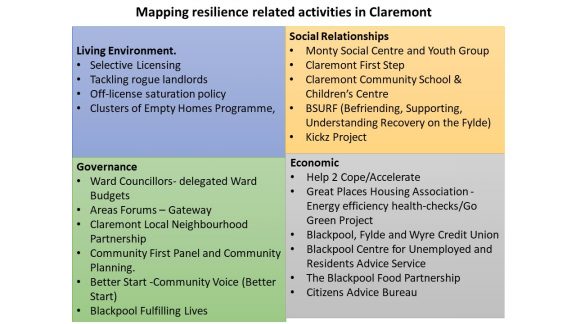Case studies
Claremont, Blackpool, Lancashire
The neighbourhood
Claremont is an area of Blackpool that suffers from severe socio-economic deprivation, including high levels of unemployment, poorer health and lower life expectancy than the national averages. Housing is predominately of poor quality, with many privately rented.

The neighbourhood players
The Local Oversight Group (LOG) in Claremont named itself ‘Claremont Together’. It included a group of residents, local councillors, the Claremont First Steps Community Centre, Great Places Housing Association and a range of professionals from Blackpool Council, including officers from housing and public health. The Hare Krishna Society joined the group in the later stages of the work and provided specific knowledge and connections to residents who don’t traditionally have a voice in this type of community building work.
Claremont Together sought to achieve two goals. The first was to improve the quality of privately rented accommodation in Claremont. Poor housing was identified as a significant issue affecting the health and well-being of residents. The second goal was to develop a sustainable partnership model of local governance. This model would bring together a diversity of stakeholders including residents, local organisations and public sector professionals. The goal of the partnership was to share resources and skills and to design actions that would change the local environment to promote health.

Implementation: enhancing systems resilience
Implementation: enhancing systems resilience
Bringing the neighbourhood system together to identify local priorities
Claremont Together held a series of events addressed at residents and organisational stakeholders. The purpose of these events was to bring neighbourhood system players in the same room, to introduce the NRP and to identify local priorities and suggestions for action.
Housing was quickly identified as a key priority and more specifically the quality of the privately rented housing sector in inner Blackpool. Engagement activities with residents and professionals made clear that poor housing and population transience were interlinked issues affecting the health and well-being of people and of the community and making it difficult to build a sense of belonging and connection with the area.
Mobilising knowledge
Working with residents, we designed, a participatory enquiry process about residents’ experiences with housing issues in the area in order to help inform and design a local intervention. We held three preparatory workshops. In the first, the Head of the Transience Project at Blackpool Council explained what the council was doing at the time and also planning to do in the future about the issue and took questions from residents and other participants. In the second workshop, residents and researchers planned the enquiry, co-produced the interview schedules, and discussed research ethics and personal safety. In the third workshop, the questions for the enquiry were finalised and participants discussed interview techniques and approaches.
Resident Advisors then interviewed other residents and relevant professionals focussing on the topic of absentee property owners. The findings were discussed with the Council’s stakeholders involved in Claremont Together and preliminary analysis identified a desire to change the practice of the Transience Programme. This change in practice included firstly; ensuring that tenants were aware of any essential improvement changes landlords had been required to make and, second, enabling tenants to safely inform the team should the landlord have failed to act.
In response to local evidence needs, a rapid evidence review on the topic of ‘tracing rogue absentee landlords’ was completed by the CLAHRC NWC team for Claremont Together.
Taking action
Claremont Together also identified four broad areas of possible action to help improve housing issues. These were: changing narratives; improving awareness among tenants in the private rented sector of their rights; engaging local letting agencies in housing standards issues and thinking about how to implement rent caps.

Changing narratives and action on housing
1. Changing narratives
This action was as a result of identifying two dominant narratives about Blackpool and Claremont. One tended to stigmatize the area by depicting it as a hopeless place full of “undesirable” members of society ‘left behind’; a place that nobody would aspire to live. The second narrative portrayed public sector professionals as being indifferent to and doing nothing to address local issues. These narratives divided the community in a dichotomy of “us” (residents) and “them” (professionals). Claremont Together sought to break that dichotomy by improving communication between key agencies and the community and ensure that tenants were fully aware of what the Council (and other partners) were already doing to improve the quality of private rented accommodation and addressing high levels of population transience in the local area.

Taking action: 2. improving awareness
2. Improving awareness among tenants of the private, rented sector of their rights
With this action, Claremont Together wanted to facilitate public access to information and training on housing rights, legal rights and available support resources. One suggestion was to look at how to improve the avenues of communication between the residents and relevant local agencies. For example, Claremont Together sought to improve the way in which the housing strategy team at Blackpool Council engaged with tenants. This involved revisiting the existing tenancy rights agreement and improving the directory of existing resources for tenants and residents.
Other activities included:
Hosting a Housing Advice Event at Claremont First Steps Community Centre at which a range of organisations attended offering free advice to Claremont residents: The People’s Team; Licensing and Enforcement; the Energy Efficiency Team; Debt and Benefit Advisors; Housing Options; Employment Advisors; Blackpool NHS Clinical Commissioning Group; Blackpool Coastal Housing and the Blackpool, Fylde & Wyre FYI Directory. There were wider community impacts emerging as a result of the event, including the opening of nine cases with local clients (five of the cases involved debt advice and four related to housing options issues). It also opened-up opportunities for the teams in attendance to engage in networking and joint working. For instance, work was planned to connect the Blackpool NHS Vanguard Enhanced Primary Care Model (Blackpool NHS Clinical Commissioning Group) with the Housing Options service.
The group worked with a local artist, members of the public, academic and professional partners to redesign an existing tenancy rights leaflet so it would be more relevant and relatable to the population in Blackpool. It was hoped this would also help to engage with vulnerable tenants about their housing rights.
3. Engaging local letting agencies.
This area of action involved setting up a conversation with local letting agencies about how they might act when landlords were unreasonably failing to respond to tenants’ complaints on housing standards and safety.
4. Advocating locally, regionally or nationally about introducing a cap on the rent tenants could be charged depending on the quality of the property.

Barriers in undertaking this work
Barriers in undertaking this work
Progress working with residents in private rented sector accommodation was slow. Claremont First Steps, our COREN organisation, felt that private tenants were difficult to engage with and difficult to keep engaged; especially those who lived in houses of multiple occupation (HMO). This feeling mirrored the experience of existing groups and local authority community workers.
A second challenge was the COREN organisation’s capacity to carry out the work. Hit hard by funding cuts, the COREN organisation was under a lot of pressure to attend to more people in need with a smaller pool of resources while, having to invest an enormous amount of time looking for new funding streams.
The high levels of transience in the area, widespread economic inequality and disenchantment with politics posed enormous challenges for residents’ involvement with programmes like the NRP. They also needed an increased investment of time to build rapport and empathy and overcome the residents’ distrust of professionals.
The LOG tried a variety of activities to build engagement with residents. Examples included administering a questionnaire to a small sample of residents to explore the links between poor quality housing and health; interviews with professionals to map out existing resources and to identify gaps in knowledge communication; and organising events for resource sharing and information. It was later agreed to expand the Neighbourhood for Learning to include the wards of Talbot and Brunswick, which is when the Hare Krishna Society joined the group.
Claremont Together partnered with the People’s Health Trust and also with the Blackpool Pride of Place partnership. The People’s Health Trust is a national organisation with a focus on addressing social inequalities in health. In Claremont, they supported a series of local conversations aimed at enabling residents to determine local priorities and actions. Given the common areas of interest, the NRP established strong links with the People’s Health Trust.
The Blackpool Pride of Place partnership brought together the business, voluntary and public sectors to promote economic development and tackle some of the area’s challenges. One of their initiatives was ‘The Claremont Project’ which aimed to tackle the concentration of deprivation in inner Blackpool through community intervention. The Blackpool Pride of Place Board asked the Health Engagement and Innovation Team at Lancaster University to help design an intervention for social change in Claremont. So in order to do this the Health Engagement and Innovation Team invited members of Claremont Together along with a wide range of researchers working on criminology, self-harm among socio-economic vulnerable populations, epidemiology and masculinities to share research expertise about Claremont and identify possible interventions.
The Team
Johann Adams – Lead for Claremont First Steps Community Centre
Liz Petch – Lead for Blackpool Council Public Health
Ana Porroche-Escudero – Academic Lead
Related Content

Related content
Lorem ipsum dolor sit amet, consectetur adipiscing elit. Nulla libero elit, viverra eget risus eu, posuere semper lorem. Lorem ipsum dolor sit amet, consectetur adipiscing elit. Nulla libero elit, viverra eget.

Related content
Lorem ipsum dolor sit amet, consectetur adipiscing elit. Nulla libero elit, viverra eget risus eu, posuere semper lorem. Lorem ipsum dolor sit amet, consectetur adipiscing elit. Nulla libero elit, viverra eget.

Related content
Lorem ipsum dolor sit amet, consectetur adipiscing elit. Nulla libero elit, viverra eget risus eu, posuere semper lorem. Lorem ipsum dolor sit amet, consectetur adipiscing elit. Nulla libero elit, viverra eget.